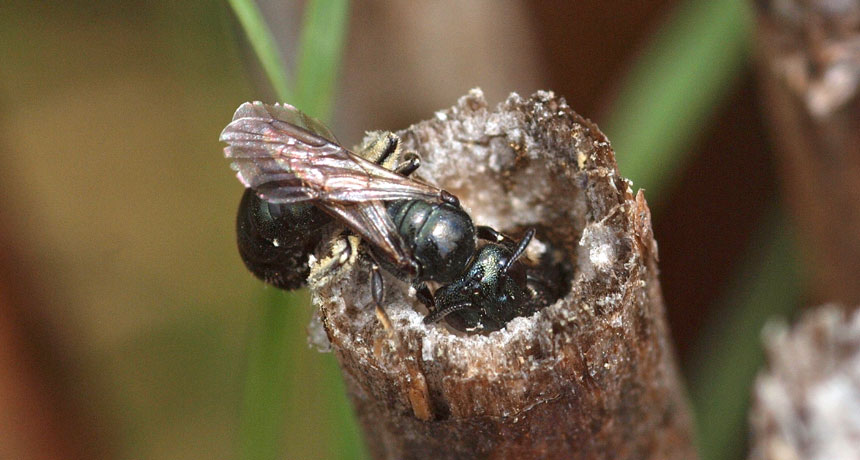
KNOCK Mother bees have to do their own hunting for pollen and nectar in the Ceratina nigrolabiata species, but a male bee (shown) eager to mate with her will watch her young while she’s gone.
Lukáš Janošík
Scientists have discovered the first case of male bees babysitting, and it turns out that these males often aren’t biological bee dads but hopeful stepdads of the youngsters.
Females of a small bluish-black Mediterranean bee (Ceratina nigrolabiata) dig out the pith of plant stems to make a nest, where a mom lays her eggs. Unlike honeybees, these are solitary bees with no colony of daughter-workers. Without that help, the mom herself must collect nectar and pollen to feed the young. But these are no latchkey larvae.
In 78 nests that researchers watched for 90 minutes, an adult male bee stayed in the nest’s entrance, rump outward, while the mom was out foraging. A male rear blocked a menacing ant that researchers put at the entrance in 41 attempted attacks. And in more than half of these attempted invasions, males pushed the ant out of the nest, says behavioral ecologist Michael Mikát of Charles University in Prague.
When mom buzzes back with food, she scratches against the male’s rump, and he moves to allow her into the nest. Then he goes back to being a dad door, or rather, a stepdad door. In 265 nests sampled, only 29 percent of the babysitting males had fathered even one offspring that they were guarding, Mikát and colleagues report the week of March 11 in the Proceedings of the National Academy of Sciences.

This male behavior isn’t some bizarre selflessness. The longer a male hangs around a female and her nest, the more likely he is to sire a youngster, Mikát found. (It’s a competition with other males for daughters. An unfertilized bee egg will grow into a male, but it takes sperm to create a female.)
Unlike honeybees, female C. nigrolabiata bees can mate at multiple points during their lives. So a male hanging around while a female is building her nest and laying eggs can still end up with one or more daughters in that nest. In terms of evolution, care for the offspring arises as a “side effect” of males looking to mate with a female while guarding her against rivals, Mikát says.
Even so, in the wild, males rarely stay with the same female for the entire time a nest develops.
Some closely related bee species also mate at various times throughout their lives, so Mikát suggests that this part of the lifestyle evolved first. That early step could have allowed the C. nigrolabiata bees to develop their simple form of biparental care, he says.
This babysitting report is a first for bees, says animal behaviorist Stephen Trumbo of the University of Connecticut in Waterbury who wasn’t involved in the research. But other insects have evolved two-parent care, he says. Some small pine beetles, for example, drill a hole in a tree, where a male and female grow fungal food and raise young. Like the bee nest, the farmstead has just one entrance, and Trumbo wonders if even an elaborate nuclear family like that could have started as happenstance babysitting of hopeful males.
Editor’s note: This story was updated March 11, 2019, to correct the credit in the second photo. Vít Bureš is the photographer, not Michael Mikát.






